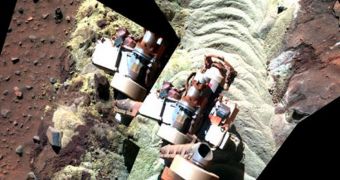According to new data collected by Spirit, it would appear that water flowed on Mars more recently than thought, perhaps even in the last hundred millennia or so.
The battered rover, which was this year designated as a stationary science station on the Red Planet, found evidence of underground water at the locations it visited before getting entangled in its sand trap.
A study of the images the explorations robot took of its surroundings shows that Troy – the patch of loose soil that caught Spirit – is made up of various layers of soil, which may have been produced by water infiltrations in the planet's not-so-distant past.
Investigators now believe that melting frost or snow may have been the main source for the water that created these layers. Martian climate changes may have provided the heat source.
A long time ago, the planet was a lot more tilted on its axis than it is today, and scientists believe that this may have causes cyclic periods of climate change to alternate, and affect its surface.
If that is the case, then it stands to reason that cooler periods would have translated in more ice forming on the surface. When hotter periods came along, the water melted and infiltrated the ground, leaving behind tell-tale signs of its passage.
As the water entered the sand, the thinking now goes, soluble minerals were carried a lot lower underground than less-soluble ones were, which may account for what the investigators are now seeing.
“Once you freeze that evidence in a rock, it can stay there for a long time. But you don't expect to maintain evidence in loose dirt for long periods of time,” says expert Bruce Banerdt.
He holds an appointment as a project scientist for the Mars Exploration Rovers (MER) mission, at the NASA Jet Propulsion Laboratory (JPL), in Pasadena, California.
“The lack of exposures at the surface indicates the preferential dissolution of ferric sulfates must be a relatively recent and ongoing process since wind has been systematically stripping soil and altering landscapes in the region Spirit has been examining,” Ray Arvidson adds.
The Washington University in St. Louis (WUSL) scientist, who is also the rover deputy principal investigator, recently made the announcement in a statement released to the press.
A paper publishing full details of the research was published in the latest issue of the esteemed Journal of Geophysical Research.
Since March 22, Spirit has remained silent at Troy, as the Martian winter struck the location. Now, experts at JPL are getting ready to reestablish contact with the rover.
If it wakes up, the robot will become the longest-duration mission on Mars, snatching the record from its twin rover Opportunity, which is currently trekking happily along on the other side of the planet.
“Most of us have high hopes. Our models say she could start communicating any day now. But we also recognize that this is an extremely risky situation for Spirit, and there are so many unknowns that we just can't be sure,” Banerdt said in a recent interview for Space.
The two rovers finished their original, 3-month-long assignments in 2004, and have been on an extended mission ever since. They sent back the data equivalent of more than 20 Martian missions.

 14 DAY TRIAL //
14 DAY TRIAL //